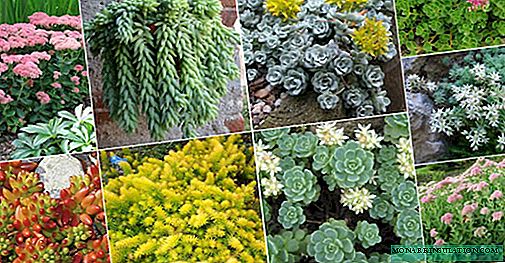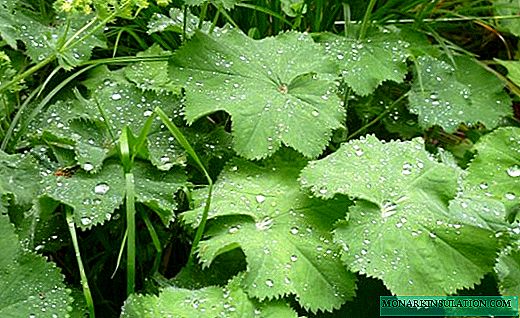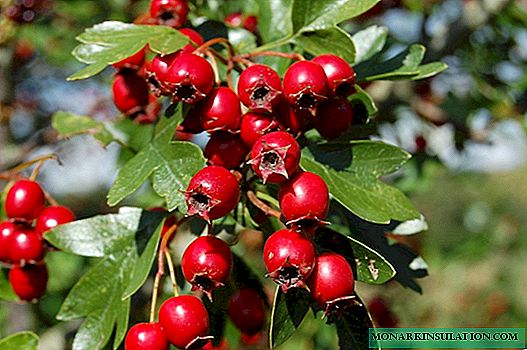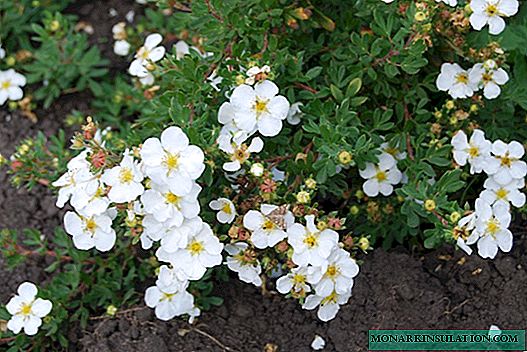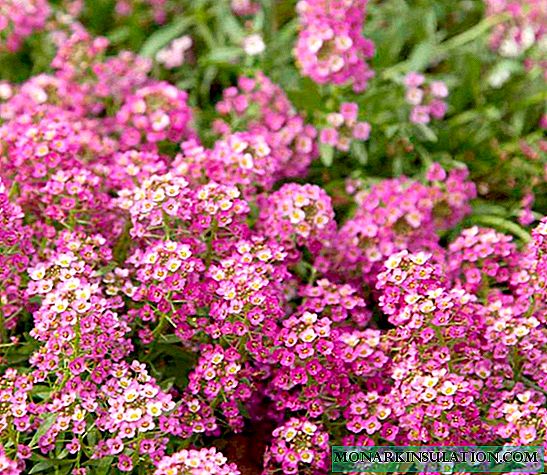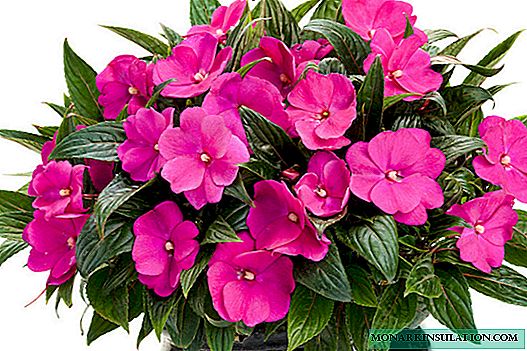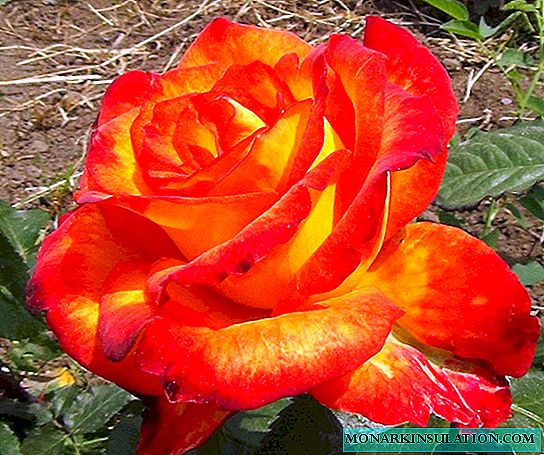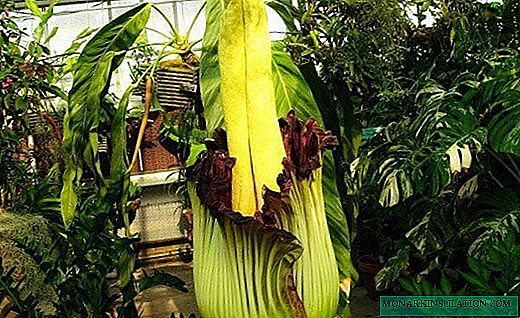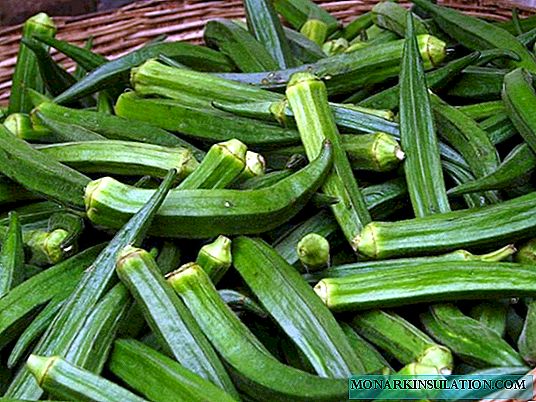
Today, many gardeners and summer residents grow not only fruits and vegetables that are usual for us, but also try to get a harvest from overseas wonders. This activity is very exciting, because caring for exotic plants, the gardener turns his beds into small experimental stations, and he becomes a researcher. Okra is still a rare plant on our farmsteads, which is why it is a wonderful view for those who like to experiment with new products.
Okra - plant description
Okra - a rare exotic vegetable can often be found under other names - okra, gombo, ladies' fingers, edible abelmosh.
The spread of okra
The plant is widespread in America, Asia, southern Europe and, of course, in its homeland - in Africa. For Russia, this is still a rather rare vegetable crop. Small plantations are grown in the Krasnodar Territory and in the Stavropol Territory, in the rest of the territories only by amateur gardeners.

Okra, planted in rows in the southern regions of Russia
Culture characteristic
Okra is a vegetable herbaceous annual of the mallow family. The height of the bush depends on the species and can be 30-40 cm in low-growing and reach two meters in tall varieties. Due to the branched thick stem and pubescent large leaves of a dark green color, the plant has a rather attractive appearance. Single large flowers of cream or milk color appearing in the leaf sinuses add decorativeness to the entire shrub. The fruits are similar in structure to pepper pods - green pubescent boxes with many seeds, in some varieties they can be quite large - more than 20 cm long.

Flowering and fruiting of okra occur simultaneously
The use of okra
They grow okra mainly as a vegetable crop. Due to its neutral taste, reminiscent of asparagus beans, it is widely used in cooking. Due to the high content of protein, vitamins, macro- and microelements, as well as low calorie content and the ability to lower cholesterol, okra is also used as a dietary product. Plant seeds are rich in oil, similar in value to olive. The fruits also contain mucous substances with enveloping properties, so dishes from okra are recommended for diseases of the gastrointestinal tract. From ripened, roasted seeds, a drink is brewed that tastes like real coffee.

Okra fruits contain a large amount of vitamins and nutrients
Sometimes on the fruits of okra there are small inclusions of burning substances. With heat treatment, the sharpness disappears, but collecting and cooking raw vegetables, especially large ones, is better with gloves. This measure will protect your hands from burns and irritation.
Video: okra - useful properties
Popular varieties of okra
Numerous varieties of okra differ from each other by the height of the bush, the size and taste of the fruits, and the duration of the growing season.
In our climatic conditions, the best yields yield:
- Star of David is a tall variety. Fruits reach a length of 15 cm.
- Red velvet is a late ripening variety. Large red fruits appear 70 days after germination.
- White velvet is one of the most popular varieties with beautiful white flowers and pods about 10 cm long.
- Clemson is a popular high-yielding variety. Of particular value are the large fruits of excellent taste.
- Blondi is a cold-resistant variety of rapid ripening with numerous cream-green fruits.
Photo gallery: popular varieties of okra

- Star of David is the most common tall type of okra
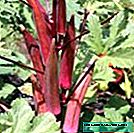
- Variety Red Velvet is decorated with bright fruits
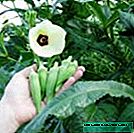
- White velvet attracts attention with beautiful snow-white flowers

- Varieties Clemson has a good fruit flavor

- Blondi fruits are light green in color.
Growing okra in various climatic zones
Okra is successfully grown in many regions of our country, however, planting methods for different climatic zones have their differences. Okra is planted mainly in seedling method. Sowing seeds directly into the soil is possible only in the southern regions - the Krasnodar Territory, Stavropol Territory, and the Caucasus. This is due to the fact that the culture is thermophilic and very sensitive to temperature drops.
In the central regions, in the Volga region, Siberia and the Urals, okra is planted through seedlings, and given the inconsistency of the weather, it is best to grow this crop in greenhouses or hotbeds.
For the good development of okra, it is important to choose a suitable place for planting. Given its southern origin, it is necessary to give it the sunniest and most sheltered area from the wind. Light fertile soil contributes to a rich harvest.
Video: growing okra in pots - useful properties
Seedling method of growing okra
Okra seeds germinate from two to four weeks, therefore, to speed up the process, they are pre-soaked. To do this, put a napkin with seeds in a saucer, moisten it with water at room temperature and put in a warm place for a day.
When soaking the seeds, it is important to prevent them from completely immersing in water - the seeds must breathe. For best results, you can moisten the cloth with rain or melt water.
Sowing seeds for seedlings
Okra seeds are planted in late April - early May. It is very convenient to use individual cups for planting, preferably peat. This is due to the fact that the okra seedlings have a root root, and there are almost no lateral roots, so they transfer the transplant painfully. The use of peat pots will allow to plant seedlings in the garden without damaging the root system.

When using peat pots, seedlings fall into the ground without damaging the roots
Step-by-step process of sowing seeds
- Set peat pots on a pallet and fill the soil for seedlings.
- In each pot, make a stick with a recess of about 4 cm.
- Lower the seed into the recess and sprinkle with earth.
- Pour water at room temperature.
- Cover the tray with pots with foil.
Okra seedlings care
During seed germination, it is necessary to maintain a temperature of about 20 degrees and periodically ventilate the pots. After the emergence of seedlings, the film must be removed, and the seedlings put in a bright warm place.
Further care for seedlings comes down to timely watering and feeding. Two weeks after emergence, the plants can be fed with a complete complex fertilizer for seedlings of vegetables. Such top dressing should be carried out every 12-14 days before transplanting seedlings to a permanent place.

Okra seedlings need to provide a warm and bright location
Planting seedlings in the ground
At the age of 35 - 45 days, okra seedlings that have grown and become stronger are planted in a permanent place. The beds with fertile soil are prepared in the fall - they make mineral and organic fertilizers for digging. Landing is best done in cloudy weather or in the evening. When planting tall varieties, between the bushes leave a distance of about 90 cm and between rows - 50 cm. Low growing plants are planted after 60 cm and 40 cm row spacing. Planted plants are well shed and mulched with peat or humus.

The grown okra seedlings are planted on the beds
Reckless way to grow okra
In the southern regions of our country with a relatively long and warm summer, okra can be planted directly in the ground. Sowing is carried out when the soil is fully warmed up and the air temperature does not fall below 16 C.
Soaked seeds are deepened by 3-4 cm. The distance between the wells is the same as when planting seedlings. Two seeds can be placed in a hole and later, when seedlings appear - weakly trim the weak ones. Level and water the land.
Care during the growing season
Okra care is simple and methods for seedling and seedling methods of cultivation are the same. After emergence, it is necessary to prevent drying of the soil. When fertilizing, it is advisable to alternate mineral phosphorus-potash fertilizers and organic.
At first, seedlings need regular care - weeding, loosening the soil, top dressing and timely watering. With the growth of okra, care is simplified - overgrown bushes do not allow the soil to dry out quickly and themselves inhibit the growth of weeds. Adult bushes can be watered less often, but abundantly, to wet the ground to a depth of 40 cm.
Bush formation
The formation of okra bush is carried out in two ways. You can grow a plant in one trunk - breaking out the emerging stepsons. Proponents of this method claim that the branches give little fruit, but take away the strength of the main shoot, which also loses its yield.
In the second method, the crown of the main stem is shortened, which stimulates the formation of lateral branches. Adherents of such cultivation believe that such molding gives a greater yield. And apparently, only experiments on their own site will help the amateur decide what method is preferable.
Fruiting okra
About two months after emergence, the okra begins to bloom, and after a week you can take the first crop. The fruits need to be collected regularly, because, after sagging two or three days extra, they become coarse and inedible. In the south, harvesting is carried out every other day, in areas with a colder climate - every 4-5 days.

Okra fruit collection
The fruiting of okra lasts until late autumn, but with a decrease in air temperature, the growth of pods sharply slows down.
When harvesting okra, care should be taken, since the plant is covered with hard, fine pubescence, which causes irritation to the skin. Therefore, working with this crop is better with gloves on.
Okra Diseases
For okra, the disease is characteristic of diseases characteristic of plants of the family malva.
The black leg is a fungal disease. Often affects the stems of okra seedlings. The diseased plant should be removed immediately so that neighboring ones are not infected. To prevent the occurrence of the black leg, you should not allow excessive moisture, often ventilate the plants if they grow in a greenhouse.
When preparing the soil for seedlings and subsequent planting in open ground, it is advisable to shed it with a solution of phytosporin. This microbiological preparation is effective for the treatment and prevention of many fungal and bacterial diseases.
Rust is a dangerous fungal disease. It appears in the form of yellow spots on leaves, stems and buds. On the inner side of the leaf brownish tuberous clusters - spores of the fungus - are found. Affected plants tend to die. If a diseased plant is found, it is necessary to immediately remove it and inspect all plantings.
Powdery mildew is a common fungal disease. On the leaves of the affected plant, you can notice a white coating, the plant is poorly developed, takes ugly forms. It is necessary to remove all leaves with white coating.
Photo Gallery: Okra Diseases

- Black-stalked sprouts
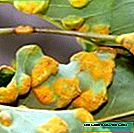
- Rust - fungal spores on the underside of a leaf

- The first sign of powdery mildew is the appearance of a white coating on the leaves
Medical and preventive measures
To combat fungal diseases, it is recommended to spray not only diseased plants with a solution of phytosporin, but also neighboring ones, as well as the soil around them. The instructions for the drug describe in detail how to prepare the drug and how often to repeat treatment.
To prevent the occurrence of diseases, when growing okra, you must adhere to the basic rules of agricultural technology:
- observe crop rotation;
- prevent thickening of landings;
- remove excess leaves, especially those touching the ground;
- fight weeds and pests, because often they are the carriers of diseases.
Errors in the application of fertilizing lead to weakening of plants and a decrease in immunity. Excess nitrogen and a lack of phosphorus-potassium fertilizers can trigger the occurrence of fungal diseases.
Pests of okra
Of the insect pests, the most likely danger to okra is represented by aphids, thrips, and cabbage scoop.
Aphids - a frequent garden guest, pulls juices from leaves, weakening the plant. An accumulation of small gray or green insects can be seen on the top of the plant and on the underside of the leaf.
Thrips are sedentary small insects that cause significant damage to plants. Settling on leaves and buds, they draw the juice from the plant. After their meal, holes remain on the plants into which all kinds of mushrooms can penetrate, so the fight against this pest must be started immediately.
Cabbage scoop - a caterpillar devouring both the leaves and fruits of okra. In a very short time, the pest is able to leave the gardener without a crop of not only okra, but also many other crops.
Photo Gallery: Okra Insect Pests

- Aphids, settling on the crown, quickly spreading throughout the plant

- Thrips pulling juice from a plant, weaken it

- Cabbage scoop eats leaves and spoils the fruits
Pest control
By following simple rules for growing okra, pests can be prevented. It is very important not to let the beds thicker, to weed out on time. Regular inspection of plants will help to notice the pest until the moment when it will be difficult to deal with it, and the damage done is noticeable. At the first detection of insects, it is necessary to treat the plantings with an insecticide. Today, on the shelves of stores a rich assortment of various means for pest control. Among this multitude, I would single out Fitoverm - a biological preparation that is low toxic and environmentally friendly. Fruits and vegetables processed by Fitoverm can be eaten in two days.
Collection, use and storage of okra
Harvested okra fruits are not subject to long-term storage. Fresh they must be used within two to three days after removal. You can use the vegetable raw, stewed or fried, as side dishes, salad ingredients or as an independent dish. For cooking, take young pods, washed and scalded with boiling water. Peels prepared in this way can be easily peeled off. This must be done so that the rough skin does not spoil the taste of the dish. Okra is prepared quickly, in just a few minutes, and at the same time its useful properties are not destroyed.

Okra stewed with vegetables
To preserve the fruits of okra for a long time, use quick freezing, drying or canning.
Okra (okra) grew without any problems, planted seeds directly in the ground (i.e., without seedlings), in the second half of May (still a thermophilic plant).
SE//dacha.wcb.ru/lofiversion/index.php?t2790.html
In the Krasnodar Territory, I grew okra. (Okra is her second name). If not mistaken - this plant is a relative of cotton. The vegetable is quite interesting, you can cook delicious dishes, but always from young knocks, as they quickly ripen and become stiff. It contains a large amount of mucous substances, relaxes the stomach well. Conditions for growth: soil and air temperature - not lower than 14-16 degrees. In the middle lane and to the north, you can try to grow in a greenhouse or under film shelter. The growing season for different varieties, from 60 to 90 days.
Ffr//dacha.wcb.ru/lofiversion/index.php?t2790.html
okra (okra) - the fruits must be removed regularly, otherwise they will be stiff, fibrous. Super delicious pickled. A very fruitful vegetable, but again, do not chase the size. Less is better. Peerless laxative.
Vx900//dacha.wcb.ru/lofiversion/index.php?t2790.html
Harvest of okra will delight gardeners and gardeners regardless of whether it is grown in a greenhouse or in the open.And dishes prepared from this dietary product will diversify and enrich any diet.












